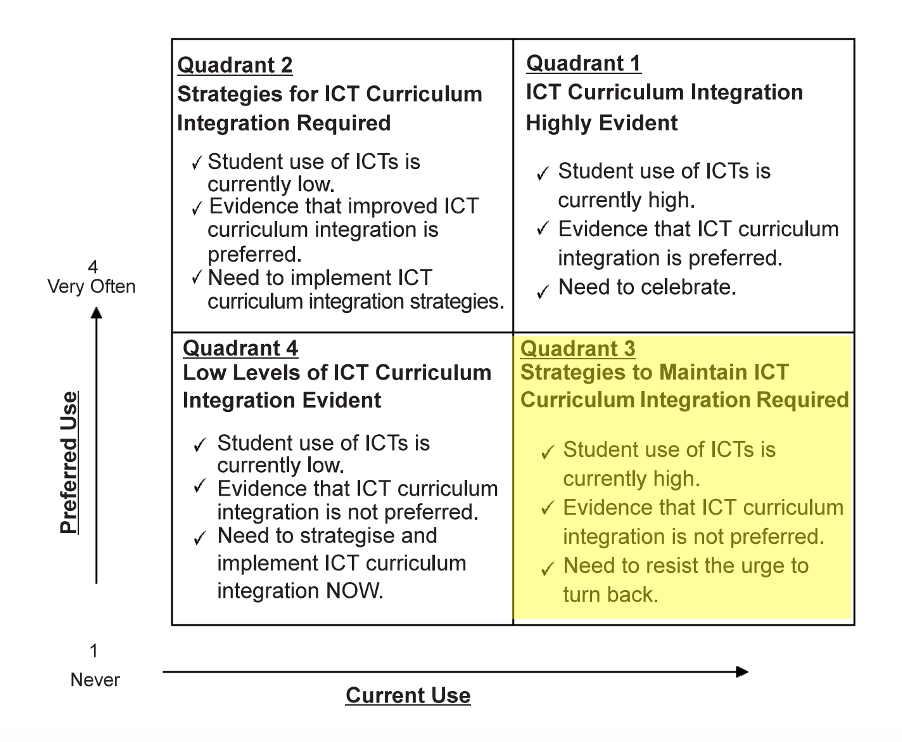If we can’t define it, we can’t measure it.
This is the beginning sentiment in Proctor, Watson & Finger’s (2003) study on measuring ICT curriculum integration. Since 2003 the need to quantify and to assess ICT integration has been a prominent area of study. Numerous methodologies, strategies and approaches used to measure integration have been suggested including using the use of questionnaires (Jamieson-Proctor et al., 2007, Christensen & Knezek, 2008), maturity models informed by international ICT competency standards (Solar, Sabattin & Parada, 2013) and “Technology Mapping” methodologies (Angeli and Valanides, 2009).
To me this diversity in assessment and measuring tools indicates that there is no one way to define ICT integration. For example, integration can be defined by,
- the consistent presence of ICT across schools and subject areas (Çapuk, 2015),
- uptake of ICT’s in schools by teachers and pupils (Cox, 2008),
- specific and a range of ICT uses (Marshall & Cox, 2008),
- its ability to empower (Gareis and Hüsing, 2009) and
- effective use of ICT in digital communication and collaboration (Shamir Inbal & Blau, 2017).
How do I define ICT integration my context?

Adapted from Proctor, Watson & Finger (2003)
Using the model by Proctor, Watson & Finger (2003), it is clear that in terms of ICT integration my current context exists within the third quadrant.
Within the scope of the project there is wide use of ICT amongst learners however at a school and community level there is still a need to justify and substantiate the efficacy of ICT integration in education. With plans for the project to be adopted into a government initiative there is a need more than ever to resist the urge to turn back. Instead it is vital to keep the foot on the pedal and continue to build capacity and increase community awareness. In doing so will it hopefully result in the following.
- See – all learners in the program using devices twice a week, multiple teachers facilitating sessions, improved learning outcomes in literacy and numeracy and increased digital literacy amongst learners, increased teacher ICT technical and pedagogical knowledge.
- Hear – parents and community members talking positively about the initiative, headteachers actively supporting teachers and students sharing their successes.
- Feel – inspired, supported and confident.
I acknowledge this is a diverse range of indicators and as such need to measured and assessed using a range of qualitative and quantitative monitoring tools.
References
Angeli, C., & Valanides, N. (2009). Epistemological and methodological issues for the conceptualization, development, and assessment of ICT–TPCK: Advances in technological pedagogical content knowledge (TPCK). Computers & education, 52(1), 154-168.
Çapuk, S. (2015). ICT Integration models into middle and high school curriculum in the USA. Procedia-Social and Behavioral Sciences, 191, 1218-1224.
Christensen, R., & Knezek, G. (2008). Self-report measures and findings for information technology attitudes and competencies. InVoogt, J., & Knezek, G. (Eds.). (2008).
Cox, M. J. (2008). Researching IT in education. InVoogt, J., & Knezek, G. (Eds.). (2008). International handbook of information technology in primary and secondary education, Vol. 20 (pp. 965–981). US: Springer International handbook of information technology in primary and secondary education, Vol. 20 (pp. 349–365). US: Springer.
Gareis, K., & Hüsing, T. (2009). Measuring transformational use of ICTs at regional level. In Handbook of research on ICT-enabled transformational government: A global perspective (pp. 351-378). IGI Global.
Jamieson-Proctor, R., Watson, G., Finger, G., Grimbeek, P., & Burnett, P. C. (2007). Measuring the use of information and communication technologies (ICTs) in the classroom. Computers in the Schools, 24(1), 167–184.
Marshall, G., & Cox, M. J. (2008). Research methods: their design, applicability and reliability. InVoogt, J., & Knezek, G. (Eds.). (2008). International handbook of information technology in primary and secondary education, Vol. 20 (pp. 983–1002). US: Springer
Proctor, R., Watson, G. and Finger, G. 2003. Measuring information and communication technology (ICT) curriculum integration. Computers in the Schools, 20(4): 67–87. http://primo.unilinc.edu.au/CSU:CSU_ALL:TN_ericEJ698975
Shamir-Inbal, T., & Blau, I. (2017). Which pedagogical parameters predict the general quality of ICT integration from the perspective of elementary school leaders?. Computers in the Schools, 34(3), 168-191.
Solar, M., Sabattin, J., & Parada, V. (2013). A maturity model for assessing the use of ICT in school education. Journal of Educational Technology & Society, 16(1), 206-218.

Leave a Reply